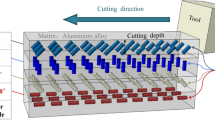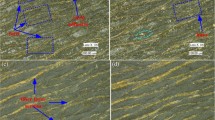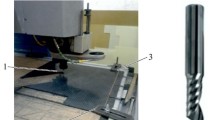Abstract
Aramid fiber–reinforced epoxy resin matrix composite is an anisotropic and heterogeneous material. And the machinability is strongly dependent on the fiber orientation. In this paper, a composite milling model was established based on fiber orientation θ. Meanwhile, a series of cryogenic cooling milling experiments were carried out to research the influence of fiber orientation on surface morphology, surface roughness, milling force, and tool wear. The results show that the acute angle milling has more advantages than the obtuse one. When tool sweeps at about θ = 55°, the maximum milling force can be gotten. And the maximum shearing action can be reached for latitude fiber at θ = 30°, as well as effectively chip broken for latitude and longitude fibers. Similarly, with increased θ, the shearing fracture is weakened with insufficient chip breaking, but none affected for longitude fibers. Besides, it can be predicted that when the cutting speeds are 50, 100, and 150 m/min, as well as fiber orientation 26°, 34°, and 35°, respectively, the processed surface roughness is 0.93 μm, 0.71 μm, and 0.6 μm. At the same time, tool wear is relatively serious with θ = 40° with a stable tool wear stage, and the processing effect is not affected. Furthermore, using the bigger cutting parameters, the better cryogenic cooling milling effect can be obtained at fiber orientation near 30° with less burr defect.












Similar content being viewed by others
References
Kusakabe K, Ichiki K, Hayashi J et al (1996) Preparation and characterization of silica-polyimide composite membranes coated on porous tubes for CO2 separation. J Membr Sci 115(1):65–75
Chen JS, Fan L, Tao ZQ et al (2006) Preparation and properties of chopped quartz fiber/PMR polyimide composites. Acta Mater Composit Sin 23(5):79–83
Sun L (2014) Study on ultrasonic assisted grinding technology of quartz fiber reinforced polyimide. Master degree thesis of Dalian University of Technology, pp 10–50
Wang FB, Wang YQ, Hou B (2016) Effect of cryogenic conditions on the milling performance of aramid fiber. Int J Adv Manuf Technol 83:429–439
Robert V, Marcel H, Friedrich K, Konrad W (2014) Chip root analysis after machining carbon fiber reinforced plastics (CFRP) at different fiber orientations. Proc CIRP 14:217–222
Shen GL, Hu GK (2006) Mechanics of composite materials. Peking University Press, Peking, pp 43–89
Zhang LC, Zhang HJ, Wang XM (2001) A force prediction model for cutting unidirectional fibre-reinforced plastics. Mach Sci Technol 5(3):293–305
Zhang LC (2001) Solid mechanics for engineers. Maemillan Press, Australia, pp 145–237
Bhatnagar RN, Naik NK, Komanduri R (1995) On the machining of fiber reinforced plastic (FRP) composite laminates. Int J Mach Tools Manuf 35(5):701–716
Su Y L (2017) Study of mechanical behavior of material in cutting carbon fiber reinforced plastic. Master degree thesis of Dalian University of Technology, pp 35–60
Sheikh-Ahmad JY (2009) Machining of polymer composites. Springer 2009:45–103
Su F(2015) The cutting process technology and its application of carbon fiber-reinforced plastic. Doctor degree thesis of Nanjing University of Science and Technology, pp 22–46
Sahraie Jahromi A, Bahr B (2010) An analytical method for predicting cutting forces in orthogonal machining of unidirectional composites. Compos Sci Technol 70(16):2290–2297
Ben Soussia A, Mkaddem A, El Mansori M (2014) Rigorous treatment of dry cutting of FRP-Interface consumption concept: a review. Int J Mech Sci 83(4):1–29
Zitoune R, Collombet F, Lachaud F et al (2015) Experiment calculation comparison of the cutting conditions representative of the long fiber composite drilling phase. Compos Sci Technol 65(3):455–466
Reed RP, Golda M (1997) Cryogenic composite supports: a review of strap and strut properties. Cryogenics 37:233–250
Schutz JB (1998) Properties of composite materials for cryogenic applications. Cryogenics 38:3–12
Sohei S, Okamoto K K K (1988) The effect of water-absorption and cryogenic temperature on the strength of ArFRP. Mater Sci Res Int 4(4):287–293
Wang FB, Liu JK, Shu QL (2017) Optimization of cryogenic milling parameters for AFRP. Int J Adv Manuf Technol 91:3243–3252
Xia T, Kaynak Y, Arvin C (2016) Cryogenic cooling-induced process performance and surface integrity in drilling CFRP composite material. Int J Adv Manuf Technol 82(1-4):605–616
Grady DE (1992) Properties of an adiabatic shear band process zone. J Mech Phys Solids 40(6):1197–1215
Grady DE (2017) Physics of shock and impact. IOP Publishing, Bristol, pp 131–204
Jiang J, Li YQ, Zhang ZY (1991) Manufacturing technology of titanium alloy parts. National Defence Industry Press, Beijing, pp 25–101
Zhang XL, Xie CH, Zhang HA (2009) Experimental investigation into the machining quality of composites influenced by fiber orientation. China Mech Eng 20:2617–2619
Yang LQ, DeVorShiv HL, Kapoor G (2005) Analysis of force shape characteristics and detection of depth of cut variations in end milling. ASME J Manuf Eng 127(3):454–462
Tlusty J, MacNeil P (1975) Dynamics of cutting forces in end milling. CIRP Ann 24:21–25
Zhuang Y (2013) Study on the combined machining technology of sawing and grinding for aramid composites. Master degree thesis of Dalian University of Technology, pp 39–48
Bhattacharyya D, Allen MN, Mander SJ (1993) Cryogeric machining of Kevlar composites. Mater Manuf Process 8(6):631–651
Funding
This research was partially supported by the Basic Science and Research Project of Liaoning Province (No. LG201711), the Liaoning Key Fund of National Natural Science Fund (No. U1608251), and the Natural Science Foundation Project of Liaoning Province (No. 20170540787).
Author information
Authors and Affiliations
Corresponding author
Additional information
Publisher’s note
Springer Nature remains neutral with regard to jurisdictional claims in published maps and institutional affiliations.
Rights and permissions
About this article
Cite this article
Wang, F., Wang, Y. Milling properties of Kevlar 49 fiber composite based on fiber orientation in cryogenic cooling. Int J Adv Manuf Technol 103, 4609–4619 (2019). https://doi.org/10.1007/s00170-019-03933-6
Received:
Accepted:
Published:
Issue Date:
DOI: https://doi.org/10.1007/s00170-019-03933-6




